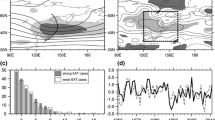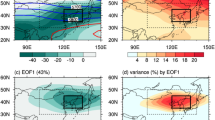Abstract
This paper examined the underlying dynamic mechanisms associated with the meridional displacement of the East Asian trough (EAT), which is closely related to the temperature variability in the southern part of East Asian winter monsoon (EAWM). During the southward displacement of the EAT, the Siberian high is stronger and the Aleutian low is displaced southward. This is due mainly to the anomalous cyclonic flow associated with seasonal eddies over the midlatitude central Pacific, which enhances the horizontal advection of cold (warm) air to the southern (northern) part of the EAT in the lower troposphere. The cold (warm) advection narrows (thickens) the height thickness and results in negative (positive) temperature anomalies in the southern (northern) part of the EAT. These anomalous circulation features can be reasonably explained by the phase of the El Niño–Southern Oscillation (ENSO). The results are also verified by the numerical experiments with prescribing ENSO-like heat source anomalies over the tropical eastern and western Pacific in an anomaly atmospheric general circulation model. All of these results advance our understanding for the linkage between the ENSO and the EAWM via its modulation of the EAT.













Similar content being viewed by others
References
Academia S (1957) On the general circulation over eastern Asia. Part I. Tellus 9:432–446
Academia S (1958) On the general circulation over eastern Asia. Part II. Tellus 10:58–75
An S-I, Wang B (2005) The forced and intrinsic low-frequency modes in the North Pacific. J Clim 18:876–885
Chang C-P, Wang Z, Hendon H (2006) The Asian winter monsoon. In: Wang B (ed) The Asian Monsoon. Springer, Berlin, pp 89–127
Chen W, Graf HF, Huang R-H (2000) The interannual variability of East Asian winter monsoon and its relation to the summer monsoon. Adv Atmos Sci 17:46–60
Chen W, Yang S, Huang RH (2005) Relationship between stationary planetary wave activity and the East Asian winter monsoon. J Geophys Res 110:D14110. doi:10.1029/2004JD005669
Chen S, Chen X, Wei K, Chen W, Zhou T (2014a) Vertical tilt structure of East Asian trough and its interannual variation mechanism in boreal winter. Theor Appl Climatol 115:667–683
Chen Z, Wu R, Chen W (2014b) Distinguishing interannual variations of the northern and southern modes of the East Asian winter monsoon. J Clim 27:835–851
Cheung HHN, W Zhou (2016) Simple metrics for representing East Asian winter monsoon variability: Urals blocking and western Pacific teleconnection patterns. Adv Atmos Sci 33:708–718
Cheung HN, Zhou W, Mok HY, Wu MC (2012) Relationship between Ural-Siberian blocking and the East Asian winter monsoon in relation to the Arctic oscillation and El Niño-Southern oscillation. J Clim 25:4242–4257
Cheung HHN, Zhou W, Lee SM, Tong HW (2015) Interannual and interdecadal variability of the number of cold days in Hong Kong and their relationship with large-scale circulation. Mon Weather Rev 143:1438–1454
Ding Y-H (1990) Build-up, air mass transformation and propagation of Siberian high and its relations to cold surge in East Asia. Meteorol Atmos Phys 44:281–292
Ding Y-H (1994) Monsoons over China. Kluwer Academic Publishers, Dordrecht
Ding Y-H, Krishnamurti TN (1987) Heat budget of the Siberian high and the winter monsoon. Mon Weather Rev 115:2428–2449
Duchon CE (1979) Lanczos filtering in one and two dimensions. J Appl Meteorol 18:1016–1022
Gong G-Y, Wang S-W, Zhu J-H (2001) East Asian winter monsoon and arctic oscillation. Geophys Res Lett 28:2073–2076
He S, Wang H (2013) Oscillating relation between the East Asian winter monsoon and ENSO. J Clim 26:9819–9838
Huang R, Chen W, Yang B, Zhang R (2004) Recent advances in studies of the interaction between the East Asian winter and summer monsoons and ENSO cycle. Adv Atmos Sci 21:407–424
Jeong J-H, Ho C-H (2005) Changes in occurrence of cold surges over East Asia in association with Arctic Oscillation. Geophys Res Lett 32:14704. doi:10.1029/2005GL023024
Jhun J-G, Lee E-J (2004) A new East Asian winter monsoon index and associated characteristics of the winter monsoon. J Clim 17:711–726
Jiang X, Li T (2005) Reinitation of the boreal summer intraseasonal oscillation in the tropical Indian Ocean. J Clim 18:3777–3795
Kalnay E et al (1996) The NCEP/NCAR 40-year reanalysis project. Bull Amer Meteorol Soc 77:437–471
Kim Y, Kim K-Y, Jhun J-G (2013) Seasonal mechanism of the East Asian winter monsoon and its interannual variability. Clim Dyn 41:1213–1228
Lau KM, Chang C-P (1987) The monsoon of East Asia and its global associations: a survey. Bull Amer Meteorol Soc 65:114–125
Leung MY-T, Zhou W (2015a) Vertical structure, physical properties, and energy exchange of the East Asian trough in boreal winter. Clim Dyn 45:1635–1656
Leung MY-T, Zhou W (2015b) Variation of circulation and East Asian climate associated with anomalous strength and displacement of the East Asian trough. Clim Dyn. doi:10.1007/s00382-015-2504-6
Leung MY-T, Zhou W (2015c) Eddy contributions at multiple timescales to the evolution of persistent anomalous East Asian trough. Clim Dyn. doi:10.1007/s00382-015-2702-2
Leung MY-T, Cheung HH-N, Zhou W (2015) Energetics and dynamics associated with two typical mobile trough pathways over East Asia in boreal winter. Clim Dyn 44:1611–1626
Li C (1990) Interaction between anomalous winter monsoon in East Asia and El Niño events. Adv Atmos Sci 7:36–46
Li T (2006) Origin of the summertime synoptic-scale wave train in the western North Pacific. J Atmos Sci 63:1093–1102
Li C, Mu M (2000) Relationship between East Asian winter monsoon, warm pool situation and ENSO cycle. Chin Sci Bull 45:1448–1455
Li J, Wu Z (2012) Importance of autumn Arctic sea ice to northern winter snowfall. Proc Natl Acad Sci 109:E1898, doi:10.1073/pnas.1205075109. http://www.pnas.org/content/109/28/E1898.short
Li X, Zhou W (2015) Modulation of the interannual variation of the India-Burma trough on the winter moisture supply over Southwest China. Clim Dyn. doi:10.1007/s00382-01502575-4
Li C, Pei S, Pu Y (2005) Dynamical impact of anomalous East-Asian winter monsoon on zonal wind over the equatorial western Pacific. Chin Sci Bull 50:1520–1526
Li RC-Y, Zhou W, Li T (2014) Influences of the Pacific-Japan teleconnection pattern on synoptic-scale variability in the western North Pacific. J Clim 27:140–154
Lim YK, Kim HD (2013) Impact of the dominant large-scale teleconnections on winter temperature variability over East Asia. J Geophys Res 118:7835–7848. doi:10.1002/jgrd.50462
Park T-W, Ho C-H, Yang S (2011) Relationship between the Arctic Oscillation and cold surges over East Asia. J Clim 24:68–83
Rayner NA, Parker DE, Horton EB, Folland CK, Alexander LV, Rowell DP, Kent EC, Kaplan A (2003) Global analyses of sea surface temperature, sea ice, and night marine air temperature since the late nineteenth century. J Geophys Res 108:4407. doi:10.1029/2002JD002670
Straus DM, Shukla J (2000) Distinguishing between the SST-forced variability and internal variability in mid latitudes: Analysis of observation and GCM simulations. Quart J Roy Meteorol Soc 126:2323–2350
Straus DM, Shukla J (2002) Does ENSO force the PNA? J Clim 15:2340–2358
Takaya K, Nakamura H (2013) Interannual variability of the East Asian winter monsoon and related modulations of the planetary waves. J Clim 26:9445–9461. doi:10.1175/JCLI-D-12-00842.1
Wang C (2002) Atmospheric circulation cells associated with El Niño-Southern oscillation. J Clim 15:399–419
Wang L, Chen W (2010) How well do existing indices measure the strength of the East Asian winter monsoon? Adv Atmos Sci 27:855–870
Wang L, Chen W (2014) An intensity index for the East Asian winter monsoon. J Clim 27:2361–2374
Wang H, He S (2012) Weakening relationship between East Asian winter monsoon and ENSO after mid-1970s. Chin Sci Bull 57:3535–3540
Wang B, Wu R, Li T (2003) Atmosphere–warm ocean interaction and its impact on Asian-Australian monsoon variation. J Clim 16:1195–1211
Wang L, Chen W, Zhou W, Huang RH (2009) Interannual variations of East Asian trough axis at 500 hPa and its association with the East Asian winter monsoon pathway. J Clim 22:600–614
Wang B, Wu Z, Chang C-P, Liu J, Li J, Zhou T (2010) Another look at interannual to interdecadal variations of the East Asian winter monsoon: the northern and southern temperature modes. J Clim 23:1495–1512
Wang X, Wang C, Zhou W, Wang D, Song J (2011) Teleconnection influence of North Atlantic sea surface temperature on the El Niño onset. Clim Dyn 37:663–676
Wu MC, Chan JCL (1995) Surface features of winter monsoon surges over south China. Mon Weather Rev 123:662–680
Wu MC, Chan JCL (1997) Upper-level features associated with winter monsoon surges over south China. Mon Weather Rev 125:317–340
Wu B-Y, Hung R-H (1999) Effects of the extremes in the North Atlantic oscillation on the East Asian winter monsoon. Chin J Atmos Sci 23:226–236
Wu MC, Leung WH (2009) Effect of ENSO on the Hong Kong winter season. Atmos Sci Lett 10:94–101. doi:10.1002/asl.215
Wu B-Y, Wang J (2002a) Possible impacts of winter Arctic Oscillation on Siberian high, the East Asian winter monsoon and sea-ice extent. Adv Atmos Sci 19:297–320
Wu B-Y, Wang J (2002b) Winter arctic oscillation, siberian high and east asian winter monsoon. Geophys Res Lett 29:1897. doi:10.1029/2002GL015373
Wu Z, Li J, Wang B, Liu X (2009) Can the southern hemisphere annular mode affect China winter monsoon? J. Geophysics. Res. 114:D11107. doi:10.1029/2008JD011501
Wu Z, Li J, Jiang Z, He J (2011) Predictable climate dynamics of abnormal East Asian winter monsoon: once-in-a-century snowstorms in 2007/2008 winter. Clim Dyn 37:1661–1669
Wu Z, Dou J, Lin H (2015) Potential influence of the November–December Southern Hemisphere annular mode on the East Asian winter precipitation: a new mechanism. Clim Dyn 44:1215–1226
Yang S, Lau K-M, Kim K-M (2002) Variations of the East Asian jet stream and Asian-Pacific-American winter climate anomalies. J Clim 15:306–325
Zhang Y, Sperber KR, Boyle JS (1997) Climatology and interannual variation of the East Asian winter monsoon: Results from the 1979-95 NCEP/NCAR reanalysis. Mon Weather Rev 125:2605–2619
Zheng J, Liu Q, Wang C, Zheng X-T (2013) Impact of heating anomalies associated with rainfall variations over the Indo-Western Pacific on Asian atmospheric circulation in winter. Clim Dyn 40:2023–2033
Zhou W, Li C, Wang X (2007a) Possible connection between Pacific Oceanic interdecadal pathway and East Asian winter monsoon. Geophys Res Lett 34:L01701. doi:10.1029/2006GL027809
Zhou W, Wang X, Zhou TJ, Li C, Chan JCL (2007b) Interdecadal variability of the relationship between the East Asian winter monsoon and ENSO. Meterorol Atmos Phys 98:283–293
Zhou Q, Chen W, Zhou W (2013) Solar cycle modulation of the ENSO impact on the winter climate of East Asia. J Geophys Res Atmos 118:5111–5119. doi:10.1002/jgrd.50453
Acknowledgments
This work is financially supported by Research Grants Council of the Hong Kong Special Administrative Region, China (Project No. CityU 11305715).
Author information
Authors and Affiliations
Corresponding author
Rights and permissions
About this article
Cite this article
Leung, M.YT., Cheung, H.H.N. & Zhou, W. Meridional displacement of the East Asian trough and its response to the ENSO forcing. Clim Dyn 48, 335–352 (2017). https://doi.org/10.1007/s00382-016-3077-8
Received:
Accepted:
Published:
Issue Date:
DOI: https://doi.org/10.1007/s00382-016-3077-8




